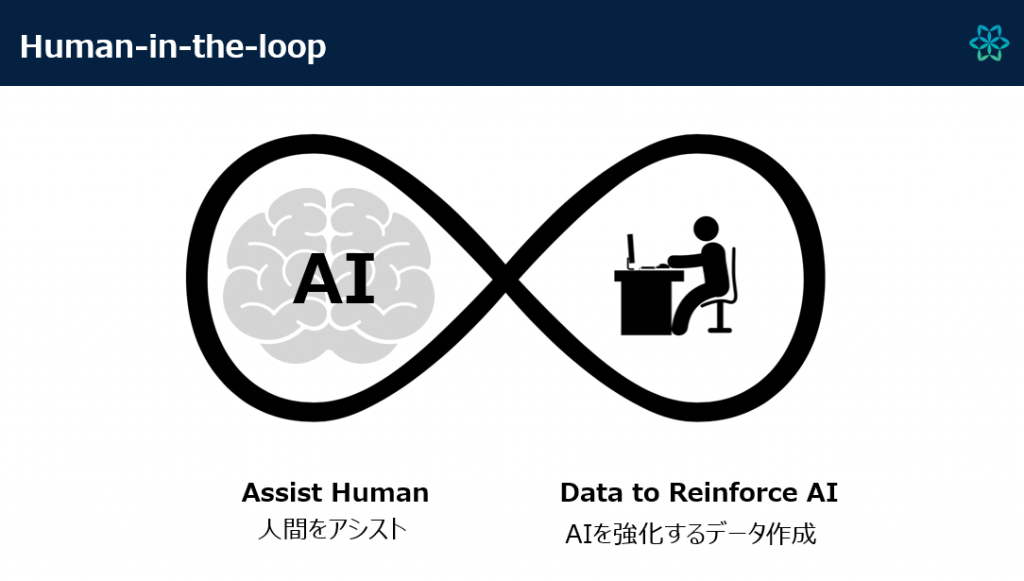
blog cinnamon blog

- management
Future AI usage patterns deciphered from five end values

Assumptions regarding work styles in the AI era
How will the way people work change as AI permeates the world? I think there are some misconceptions about this. First, AI does not take away people's jobs, but rather collaborates with people.
IT and AI are similar and different. Specifically, while IT operates within rules defined by humans, AI is intuitive using deep learning. Therefore, while IT is limited in scope, AI can be used in various genres. The biggest difference caused by this is the presence or absence of errors. Errors are inherent in AI.
Some people may feel uneasy about incorporating AI due to the possibility of errors. Therefore, even if a system is highly automated using AI, by leaving some judgment and control in the hands of humans, AI will further improve its accuracy.
For example, when a person makes corrections to text data read by OCR that is not accurate, the AI uses machine learning to improve the accuracy of the work. In other words, this is a cooperative relationship in which AI assists humans in their work, while humans create learning data to strengthen the AI.
This is the concept of "Human-in-the-loop" and is part of the new way of working in the AI era.
Specific model of “Human-in-the-loop”

There are broadly three possible patterns for this "Human-in-the-loop" model.
One is the ``detection model,'' as mentioned above, in which humans check and correct what is automatically output by AI. The second is a ``backup model,'' in which an AI chatbot is used while humans handle complex responses. Thirdly, the AI's confidence level is calculated in advance, and if the score is above a certain level, the AI automatically outputs it and reflects it, but if it is below a certain level, it is reflected after a person checks it. , a "supervision model".
In fact, this ``Human-in-the-loop'' is still in operation in places very familiar to us. For example, the Google Translate interface. At the bottom right of the box that displays the translated word is a command to copy the text. This helps further improve the accuracy of automatic translation.
This is because the user will only press the copy button and adopt the translated text when they are satisfied with the translation accuracy. Conversely, if the translation accuracy is obviously poor, the copy button will not be pressed. In other words, this model naturally continues to accumulate useful learning data.
Business opportunities through the use of AI until 2025!

These AI technologies are already beginning to be democratized. It goes without saying that in the coming era, skillful use of AI will determine the success or failure of a business.
Cars, which we take for granted on the streets today, came into our lives around 100 years ago when Ford democratized their technology. The same thing will happen in the world of AI in the future. The democratization of AI technology will cause a game reset across industries, forcing companies to change their strategies.
In fact, there have already been a number of great success stories in the United States. For example, Lemonade, an online non-life insurance company that uses an AI chatbot to complete enrollment procedures in just a few minutes, went public a few months ago, and its market capitalization has already exceeded 410 billion yen. . This is impressive considering the company was founded only five years ago.
Additionally, Mobileye, which develops software and hardware for autonomous vehicles, was acquired by Intel in 2017 for approximately 1.7 trillion yen. Considering that it was founded in 2015, it has built up this much value in just two years. These are all examples of successful use of AI in growth strategies.
Similar opportunities may exist for Japanese companies. However, the time limit is 5 years. Expressions such as the ``2025 wall'' are already being used in Japan, and when it comes to AI, it is believed that the competition will be largely over in the next five years.
That is why strategic design in the AI era is extremely important. So how can you build it without much initial investment?
Five end values brought by AI

What's important here is to clear up the second misconception about AI. This is the belief that only engineers can deeply understand AI. But in reality, it is possible to roughly understand what AI can do from a business case.
For example, LawGeex, an American legal company, uses AI to provide services that do not require a lawyer. Lawyers have traditionally spent hours examining a single contract, checking the details and verifying the logic, but this is exactly what AI is good at. By using machine learning, we have succeeded in significantly reducing the amount of labor and time required.
Another American company, AgShift, is a company that incorporates AI into food quality inspection. We automate inspections by photographing the contents of product packages and analyzing the images to determine whether food and beverages being distributed comply with national standards. It goes without saying that it is much faster than testing manually.
The end value that can be obtained from an AI strategy, which can be deciphered from these examples, can ultimately be narrowed down to five things: improved operational efficiency, reduced risk, increased sales, improved UX, and R&D. When considering an AI strategy, it is important to start from the perspective of ``What end value will we provide?'' rather than ``What can we do with the data we currently have?''
Regarding R&D, the term digital twin has become more common in recent years. Digital twin refers to the virtual reproduction of the physical environment by sending information from the physical space to cyberspace.
An obvious example is car manufacturers, who are beginning to use digital twin technology when developing new cars to virtually create cars with the same specifications and conduct tests such as crash tests that are difficult to perform in real life. Even with Maclaren, which is famous for F1, extremely realistic simulations are conducted to see how the car can run on the course based on the specifications of the car. With this, no matter how many cars you break during the test, it won't cost you anything.
The number of such cases will increase in the future. AI is by no means remote to all industries. How to incorporate AI into corporate strategy can be calculated backwards from these five end values and business cases.
 Cinnamon AI President and CEO Mirai Hirano Serial Entrepreneur. Completed graduate school at the University of Tokyo. Engaged in research on recommendation engines, complex networks, clustering, etc. It was twice selected for the IPA Unexplored Software Creation Project in 2005 and 2006. Founded Naked Technology while still in school. We develop and operate middleware that allows you to develop applications on IOS/ANDROID/flip phones. In 2011, the company was sold to Mixi. Received various domestic and international awards such as ST.GALLEN SYMPOSIUM LEADERS OF TOMORROW, FORBES JAPAN “Entrepreneur Ranking 2020” BEST10, Woman of the Year 2019 Innovative Entrepreneur Award, VEUVE CLICQUOT BUSINESS WOMAN AWARD 2019 NEW GENERATION AWARD . He has also given a keynote speech at AWS SUMMIT 2019, Milken Institute Japan Symposium, 45th Japan-ASEAN Management Conference, Bloomberg THE YEAR AHEAD Summit 2019, etc. Since 2020, he has been appointed as a member of the Cabinet Secretariat IT Strategy Office and a special member of the Cabinet Office Tax Investigation Committee. From 2021, he will serve as an expert member of the Cabinet Office's Economic and Fiscal Policy Council. In her private life, she is a mother of two children. Cinnamon AI President and CEO Mirai Hirano Serial Entrepreneur. Completed graduate school at the University of Tokyo. Engaged in research on recommendation engines, complex networks, clustering, etc. It was twice selected for the IPA Unexplored Software Creation Project in 2005 and 2006. Founded Naked Technology while still in school. We develop and operate middleware that allows you to develop applications on IOS/ANDROID/flip phones. In 2011, the company was sold to Mixi. Received various domestic and international awards such as ST.GALLEN SYMPOSIUM LEADERS OF TOMORROW, FORBES JAPAN “Entrepreneur Ranking 2020” BEST10, Woman of the Year 2019 Innovative Entrepreneur Award, VEUVE CLICQUOT BUSINESS WOMAN AWARD 2019 NEW GENERATION AWARD . He has also given a keynote speech at AWS SUMMIT 2019, Milken Institute Japan Symposium, 45th Japan-ASEAN Management Conference, Bloomberg THE YEAR AHEAD Summit 2019, etc. Since 2020, he has been appointed as a member of the Cabinet Secretariat IT Strategy Office and a special member of the Cabinet Office Tax Investigation Committee. From 2021, he will serve as an expert member of the Cabinet Office's Economic and Fiscal Policy Council. In her private life, she is a mother of two children. |
At Cinnamon AI, we help you connect AI to your competitive strategy through consulting, workshops, and solutions. We would appreciate it if you could feel free to contact us.
Click here to contact us => Inquiry form
Recommended articles
-
 management
management -
 management
managementPurpose formulation and harvest loop based on customer experience
Purpose formulation and harvest loop based on customer experience
-
 management
managementThe concept of “Expert-in-the-Loop” where humans and AI work together
The concept of “Expert-in-the-Loop” where humans and AI work together
